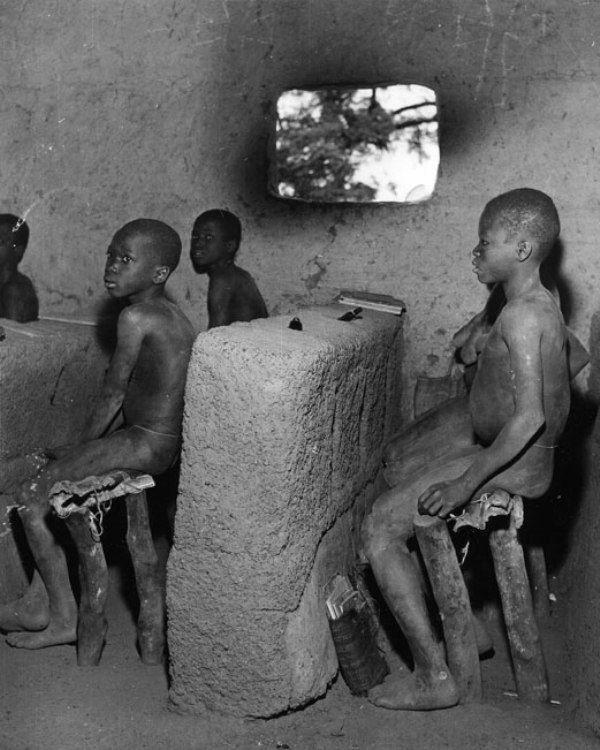
Benin Education

Figure 1.--This photograph shows a village school in the then French colony of Dahomey during the 1950s. French colonialpolicy devoted very limited resources to education, although efforts to support educatiion did increase after World war II. While schools existed in the cities, few were available in rural areas. Village schools, if they existed, were very rudimentary.
This one seems to have had virtually no teaching materials, but the building itself is substantial. The only facilities are mud desks and wooden benches. The pupils have bags with some books, but they don't wear any clothing except waist laces.
|
|
Benin is the former French colony of Dahomey. The first schools were missionary schools. Franch made only limited efforts to establish a school system during the colonial period. France granted independence (1960). A democratically elected government set about building a public school system, although resources were limited. The educational model was the French system. The effort was impaired by the ethnic strife which bedelved the new country. A military coup established a Communist dictarorship. The Marxist-Leninist state was the People's Republic of Benin (1972-90). The military as well as many educated beklieved that Capitalism was a filed system and that Socialism would lead to the rapid modernization of the country as xwell as the enrichment of the ruling elite. As in the several other countries that followed this approach was both political repression and economic failure. This inevitably affected the education system. The Marxist military rejected French culture ans as part of that effort sought to replace the French education system. Reforms introduced a strong dose of Marxist-Lenist ideology into the curiculum, but the Frebch model persisted in part because all the country's teachers had been trained in schools using the French model. The Government made primary education compulsory. The primary schools are for children 6-11 years of age. Secondary schools offer another 6 years of education. Another six years of secondary education follows the primary education. The enrollment of boys during the 80s in the primary schools were double than the girls. The country's economic failure as a result of mismanagemnt and socialist policies severly affected the standards and availability of education. The Marxist dictatorship was replaced by the multi-party Republic of Benin (1990). The new government gave education a high priority. One of the efforts was to promote girls' education and in just a few years enrollment approached that of boys. The National University of Benin at Cotonou was founded (1970).
HBC

Related Chronolgy Pages in the Boys' Historical Web Site
[The 1880s]
[The 1890s]
[The 1900s]
[The 1910s]
[The 1920s]
[The 1930s]
[The 1940s]
[The 1930s]
[The 1940s]
[The 1950s]
[The 1960s]
[The 1970s]
[The 1980s]
Related Style Pages in the Boys' Historical Web Site
[Long pants suits]
[Knicker suits]
[Short pants suits]
[Socks]
[Eton suits]
[Jacket and trousers]
[Blazer]
[School sandals]
[School smocks]
[Sailor suits]
[Pinafores]
[Long stockings]
Navigate the Boys' Historical Clothing Web Page
[Return to the Main African school country page]
[Return to the Main Benin page]
[Introduction]
[Activities]
[Biographies]
[Chronology]
[Clothing styles]
[Countries]
[Bibliographies]
[Contributions]
[FAQs]
[Glossary]
[Images]
[Links]
[Registration]
[Tools]
[Boys' Clothing Home]
Created: 7:32 PM 2/27/2013
Last updated: 7:32 PM 2/27/2013




